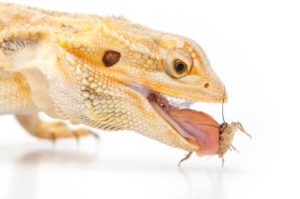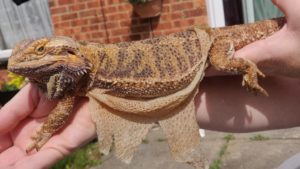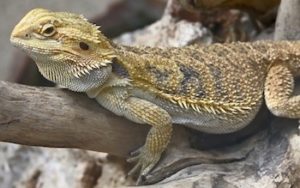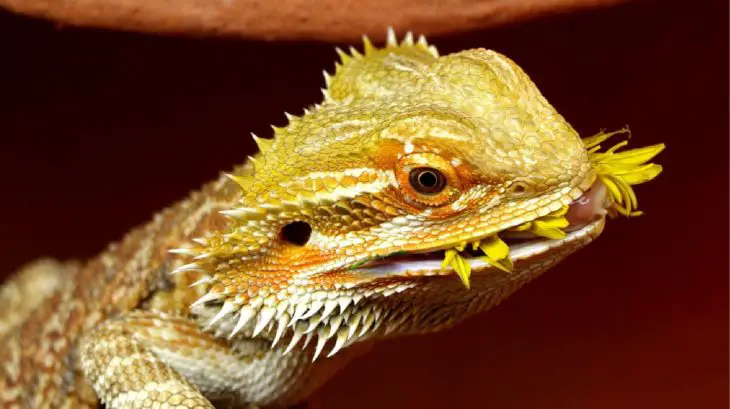The bearded dragon lives in dry and rock-strewn regions of Australia. When it gets excited or angry, it puffs out its’ throat. This gives the lizard a beard-like appearance. Hence, how the animal got its’ name. Its’ most distinguishing features are the spikes on its’ sides.
Although they appear sharp, they are flexible and gentle to touch. Bearded dragons also have a triangular-shaped head and a flat body. The desert environment in which they grow makes them skilful climbers.
In the 1990s, families in the United States began welcoming them into their homes. “Beardies”, as they are affectionately called, make good pets. They are sociable reptiles. They enjoy being cuddled and petted.
One thing to be aware of, though, is that their diet and environment requirements have a level of complexity to them. For instance, some pet owners may notice that their bearded dragon isn’t eating. This article will discuss why that may be the case and what can be done about it.
Before we talk about why your bearded dragon is not eating and how to treat it we will first look at what it should be eating and drinking.
What Sort of Food Does a Bearded Dragon Eat?
Bearded dragons are omnivores. Their diet is primarily plant based. Some of their protein comes from mice. The rest of it comes from insects like the cricket, locust and cockroach. Meat makes up about 75% of the lizard’s diet. The other 25% comes from fruit and vegetables. If you would like to read a guide that I wrote about bearded dragon diet and feeding then check out this link.
Meat
A bearded dragon will eat a wide variety of foods in the wild. Since they must work to catch their prey, their diet isdependent on their natural habitat. As for a domesticated lizard, they lead a more sedimentary lifestyle. It is best to reduce their protein intake as they get older and are less active. That is because eating too much meat can cause the beardie to become overweight.
Live insects are ideal in a bearded dragon’s diet. The lizards can chase and eat them, like they would in the wild. Before serving them to your pet, however, feed the insects first. The nutrients digested by the bugs will then be passed on to your pet.
There are two insects that can only be eaten by adult lizards. These are the mealworm and its’ larger counterpart, the superworm. They are hard to digest and, in younger dragons, can cause constipation. If live insects end up in your pet’s water bowl, remove them quickly. If this becomes a habit, you can purchase a cover to place on top of the bowl.This avoids them falling in again in future.
Avoid feeding your pet these ingredients:
- Insects that aren’t from the pet store, as they may have parasites
- Bugs that glow, such as fireflies, because they are toxic.
- Seafood and fish
Also be sure to not make your pet bite off more than they can chew. The portion size of the beardie’s food should be no bigger than the space between their eyes. They may enjoy mice occasionally, but they require more work to digest.
Plants
When it comes to fruits, many of them are sweet treats for your pet. However, they should be eaten sparingly. Veterinarians recommend feeding soft fruits at a frequency of once a month. This helps avoid problems with the lizard’steeth. They can also eat an array of vegetables and greens.
Before serving fruits or vegetables to the dragon, be sure to have peeled them and chopped them into little pieces first. The smaller the better, with baby and young dragons.
The foods below should not be fed to your pet: Iceberg lettuce, spinach, beet leaves, rhubarb and avocadoes. These contain chemicals that can be fatal to your pet.
Vitamins and supplements
Bearded dragons under six months will need these daily. Until about a year, they can have these once every two days. After a year old, you can integrate them into their diet every three days. The most important supplements for a dragon are calcium and vitamin D3. Calcium prevents them from getting metabolic bone disease. The vitamin, on the other hand, replaces the natural sunlight they’d be lacking in captivity.
There are two ways that these can be integrated in the bearded dragon’s foods. With fruits and vegetables, simply dust the calcium and vitamin powder onto them. With live insects, gently shake them up in a container with some powder.

Crickets and other insects are important foods to bearded dragons
How Often Should a Bearded Dragon Eat?
Juvenile
Young bearded dragons will eat up to three times a day. Since they are growing, their diet needs to include more sources of protein. They have a big appetite. You can add insects over three feeding periods. These can vary between 10 and 15 minutes in length. Baby bearded dragons can eat up to sixty bugs a day. Just be sure not to overfeed your pet, as this can lead to paralysis and even death.
Adults
Many experienced pet owners suggest adapting the nutrition ratio of insects to vegetables to the dragon’s age. A teenaged bearded dragon’s diet can be split about half-half. As for an adult, they should only eat insects once a day. The other 70-75% of their food intake should be vegetation.
How Much Should a Bearded Dragon Drink?
The water a bearded dragon can get from their food isn’t enough. To help them stay hydrated, they should have regular access to fresh, drinking water. Choose a shallow bowl to prevent drowning. Place it in an area of the terrarium that is a little cooler in temperature. Keep it clean by washing it first thing in the morning. Tap water is fine, but you might want to use a conditioning product to remove minerals and chlorine.
If there are traces of food debris or poop in the water, sanitize the bowl with a gentle detergent and rise it well. To calculate how much water your pet should drink, calculate its’ body weight. Its’ daily water intake should be 10-30 millilitres per kilo. This averages 2 teaspoons for an adult lizard.
Drinking from a bowl isn’t something that comes naturally to a beardie. That’s because they do not see waterwhen it is stagnant. A good trick to draw them to the bowl is by placing a sweet fruit in it. The smell will entice your pet to start drinking from the bowl. This also enhances the taste of the water, making it more appealing to drink. Another way to help your bearded dragon stay hydrated is by using a water misting spray. This will cause your pet to lick the droplets off its’ nose. This method is ideal with baby dragons.
The Reasons Why A New Bearded Dragon Isn’t Eating
Stress
If you just bought your bearded dragon, it may be feeling a little stressed. Unfamiliar surroundings can be destabilizing at first. To help them settle in, place some hiding retreats in its’ enclosure.
Some pet owners make the mistake of putting more than one lizard per cage. They may seem to tolerate the presence of the other animal. However, they are solitary creatures. If a lizard’s appetite has reduced, it may be feeling threatened or afraid of the other beardie. You may notice your bearded dragon waving in this instance!
What Can Cause a Bearded Dragon to Stop Eating?
Brumation
You may have noticed changes in your pet’s behaviour. Have they stopped eating, become inactive and are constantly trying to hide? It may be brumation season. It is tied to the bearded dragon’s survival instincts in the wild. This happens when the temperature outside begins to drop. As a result, they will cover themselves with dirt. Their metabolism rate will slow down significantly. In such a scenario, there is no cause of concern. If you would like to read more about brumation check out this handy guide.
Inadequate housing
As mentioned at the beginning of this article, a proper environment is important. This can be done with the right equipment. Let’s look at lighting. Their enclosure must have UVA, UVB and basking lights. UVB imitates the sun’s rays.That light bulb should be switched every six months. UVA gives the light we can see. White light gives lizards the best visibility.
It should also contain a ceramic heat emitter to keep them warm. In terms of terrariums, ones made with glass or plastic are a good choice. They often come with screen lids that allow for air to flow freely while keeping a low level of humidity. Regarding the size of the tank, this will depend on the age and size of your pet.
The tank should be between 20 and 75 gallons. For the flooring of its’ vivarium, choose substrate that has no particles. This is the best option, as it doesn’t produce debris that risk being ingested. Loose-fitting substrate can be a cause of irritation to the nose and eyes as well as impaction.
The proper platform also helps in a lizard’s digestion. Provide them with a large branch or rock that can bring them within close distance of the basking light. Places to hide and sleep in are equally beneficial.
An essential part of a bearded dragon’s living quarters is heating. Interestingly, the temperate isn’t consistent throughout the terrarium. One side must be hot, between 95 and 110 degrees. The other side is a little cooler, at 75 to 80 degrees. A thermometer on each side of the cage is a smart purchase for reptile owners. The heating should be regulated to these respective temperatures for 12 hours. When the lights are off at night, temperature should be no lower than 65 degrees.
Impaction
This takes place when there is a blockage in the lizard’s digestive tract. This makes it unable to pass bowel through its’ body. Many problems can cause impaction. A loose-fitted substrate in its’ enclosure, for instance, is harmful to your pet. They may not intentionally eat the vivarium’s flooring.
However, it can get caught on their food. An accumulation of these materials can eventually lead to clogged intestines. Another factor that can cause impaction is the size or the quantity of the insects fed to them. Some of them may have an outer skin that is too hard for the reptile to digest. And lastly, the temperature in the tank may also be to blame for impaction. As heat aids in digestion, remember to keep the tank between 95 and 105 degrees. And for babies, 105 to 110. Feed your pet a few hours before turning the lights off for the night.
If your beardie hasn’t urinated or defecated in a few days and you notice changes in their mood and character, this is a tell-tale sign. Impaction is much more serious than human constipation. It can cause your pet to lose mobility in its’ legs. When this happens, they will be dragging their hind legs behind them as they walk. Look out for a bump on the animal’s back, too. This may be where the blockage is.
What Causes a Baby Bearded Dragon to Stop Eating?
Shedding
Has your pet’s skin colour changed? Is it appearing more dull or dark? This may be a sign that your pet’s going to change skin. In the first six months of a bearded dragon’s life, they will shed on a weekly basis. This is due to a rapid growth.
Shedding will occur less frequently after six months of age. In the days leading up to a shed, a beardie won’t be feeling its’ best. Consequently, they may not have their usual appetite. Some may lose it altogether. They will feel tired during the shedding period and may simply want to rest. Bulging eyes during this time is normal, as it allows skin to stretch and loosen in that area.

When a bearded dragon is shedding it can be put off its food.
How Can You Help a Bearded Dragon That Will Not Eat?
If your pet is suffering from impaction, you can help stimulate bowel movement. First, fill a recipient with enough water that your pet can swim in it a little. Next, make gentle, massaging motions on its’ stomach and cloaca. You may also try putting a few drops of olive oil on your beardie’s nose. Licking it can help their bowels flow more easily.
Another thing you can do is make some changes in their diet. You’ll want to favour soft foods. Some suggestions are warm fruit compote, like what babies eat. You can also feed them pumpkin puree or fruit juice after diluting it with some water.
For a pet that is experiencing shedding, they won’t feel hungry. However, there are things you can do to help them feel better. Try spraying mist on the dragon. You can also give it a warm bath. This will cause their skin to get softer and will fall off more easily.
In the case of brumation, the best thing to do is help prepare your pet for everything it entails. You’ll want to imitate the conditions that usually call for a lizard to hibernate. Gradually decrease the tank’s temperature. This can be done by getting a lower light bulb or having the lights on for shorter periods of time. Also begin to decrease the amount of food you give them. Brumation can last from a few weeks to up to four months.
What Should You Do if Your Bearded Dragon Still Won’t Eat?
Sometimes a bearded dragon won’t eat because they are ill. Some signs to look out for are diarrhea, low energy levels or eyes that appear droopy or swollen. In such a scenario, it is preferable to pay a visit to the veterinarian. These animal health specialists are in the best position to give your pet the extra care it might need.

It can be a real worry when your bearded dragon will not eat
Conclusion
Bearded dragons are great pets but have specific nutritional and environmental requirements. Become familiar with what foods, plants and vitamins they should eat and how often. There are times when your pet won’t eat. Several things can cause this to happen. Most of the time, these are situations you can handle on your own. On the other hand, when in doubt, it is best to ask for help. For more helpful guides and articles about bearded dragons on this website please click this link to be taken there.
